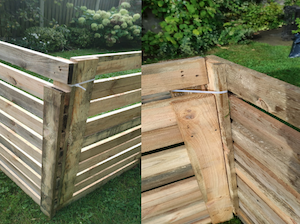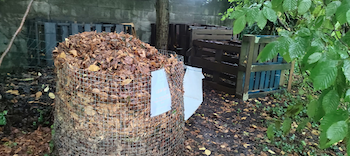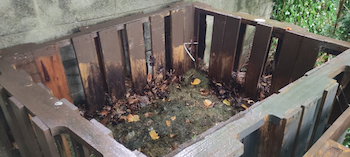European Sustainable Development Goals (SDG) Week 2023
- castleknocktidytowns
- Sep 25, 2023
- 4 min read
Updated: Nov 7, 2023
Ireland Sustainable Development Goals week forms part of the wider European Sustainable
Development week. The European SDG Week 2023 is an event aimed at
promoting knowledge exchange and sharing best practices in sustainable development
according to the UN goals. As part of SDG week Castleknock Tidy Towns (CTT) are promoting
the ‘Community Composting Made Easy- Too Good to Waste and how it supports SDGs and
climate action.
CTT is a voluntary group of individuals who donate time and energy to work on environmental projects and community cleanups around Castleknock village. In line with CTT’s mission to foster and promote environmental projects, CTT organised a Community Composting Project. One of our aims is to make Castleknock more sustainable.
Amongst many activities, CTT has planted over 1,500 trees and created pollinator beds. To
support the trees (SDG # 15), pollinator beds (SDG #13), reuse our gardener’s waste (SDG
#12) and become more sustainable (SDG #11) we have created a plan for community composting (Leaf Bays, Composting Bays and Grass sods (Loam stacks)).
With the increased visibility of CTT’s Leaf Bays, Composting Bays and Grass sods/ Loam stacks,
we are raising positive climate action awareness and encouraging the local community to
reuse waste, make compost and to take action to combat climate change. The project is outlined below.
First is the Plan and then the Process to Build Compost Bays.
Some Tips and our Awareness Campaign through CTT Volunteers and Social Media, which
includes how the project aligns with SDGs and Climate action.
1. Plan to build leaf bays, compost bays and grass sods bay/loam stacks.
2. Process to build
3. Tips
4. Awareness Campaign through CTT volunteers and social media, which includes how
the project aligns with SDGs and Climate action.
Plan to build leaf bays, compost bays and grass sods /loam stacks.
Agree location of leaf bays, compost bays and grass sods/loam stacks
Location should be easily accessible and close to gardener’s waste disposal.
Each location has 2 leaf bays, 1 compost bay and 1 grass sod pile/loam stack. (2 Leaf bays to facilitate decomposition/ breakdown for Year 1 and year 2)
The compost bays are painted dark grey/black and if in a visible location screened by hedging.
Consider having hinges at the front of the bay (like a gate) to allow easy opening.
Use a pallet style leaf bay or compost bay with a gate, as a leaf cage/compost cage is very difficult to remove the leaf mulch or compost from the bays.
Consider installation time and be ready for early Autumn to collect falling leaves and wet grass.
Benefits of pallet style bays: They can be reused and are less costly.
Grass sods/Loam stacks were a recent addition due to the large amount of gardener’s waste from grass edging throughout the village.
Process to build (Pallet Type Compost Bay)
Clear site. See Tips (Very Important)
Build the pallet style Leaf Bay/ Compost Bay
Nail pallets together to ensure gaps are suitable.
Assemble the sides and secure together with cable ties
Insert hinges to create the gate for easy use.
Paint if required.
Place in a clear site, near trees and easily accessible for people to fill and use.
Screen to reduce the visual impact.
Tips
Clear site. Note these Tips as they are very important considerations.
No Ivy. If Ivy is present, you can’t use the compost.
No Perennial weeds. They may regrow in the compost.
No seeds, as they will germinate in the compost.
Gardener group to advise, on which weeds are suitable to be composted.
Leaf Bays: Fallen Leaves only.
Compost Bays: Equal mix of green (grass) and brown (leaves) waste. (Note grass generates heat)
Compost Bays: To speed up mix occasionally to oxygenate.
Gardener’s waste only for community composting (i.e. leaves, grass and weeds). No household waste.
Grass Sods will decompose to loam (nutrient rich soil)
Loam holds nutrients and has a texture that retains water long enough for plant roots to access it, yet it drains well — meaning that the water eventually seeps away, so that plant roots do not sit in water and rot. Without quality soil, plants struggle to survive and usually require supplemental feeding and watering.
Below are some points on how our project ‘Community Composting Made Easy - Too Good
to Waste' aligns with SDGs:
SDG 11 Sustainable Cities and Communities -Use locally, avoid carbon footprint.
SDG 12 Responsible Consumption and Production- Reuse waste and produce our
own compost. Avoid local authority transport to dispose of waste, reduce carbon
footprint.
SDG 13 Climate Action – Regenerate the soil with gardener’s waste.
SDG 15 Life on Land – Protecting and supporting trees and urban forests.
Reuse is nature’s way. We can borrow ideas from Mother Nature. It requires
everyone to cooperate and work together. Everyone has a relationship with the soil,
as food is a daily essential in our lives.
Social Media Campaign and how the project aligns with SDGs and is a positive
climate action and contribution to life on land and sustainability. This European Sustainable Development week, CTT will be highlighting some tips on community composting and how composting contributes to meeting the Sustainable Development Goals, through CTT volunteers, CTT website and online social media.
People will learn how our valuable gardener’s waste can be reused and put back into
the soil for more soil regeneration and more growth. Benefits of leaf bays, compost bays, grass sods/loam and how their use supports SDGs and positive action for climate change.
Links to the SDG website promoting awareness of all SDG projects and events will be
circulated. Every action counts! Everyone counts!

.png)


















Comments